UMass Extension's Landscape Message is an educational newsletter intended to inform and guide Massachusetts Green Industry professionals in the management of our collective landscape. Detailed reports from scouts and Extension specialists on growing conditions, pest activity, and cultural practices for the management of woody ornamentals, trees, and turf are regular features. The following issue has been updated to provide timely management information and the latest regional news and environmental data.
The Landscape Message will be updated once a month in October, November and December. The next message will be posted on November 5. To receive immediate notification when the next Landscape Message update is posted, be sure to join our e-mail list
To read individual sections of the message, click on the section headings below to expand the content:
Scouting Information by Region
Environmental Data
The following data was collected on or about September 29, 2021. Total accumulated growing degree days (GDD) represent the heating units above a 50° F baseline temperature collected via regional NEWA stations (http://newa.cornell.edu) for the 2021 calendar year. This information is intended for use as a guide for monitoring the developmental stages of pests in your location and planning management strategies accordingly.
|
MA Region/Location |
GDD |
Soil Temp |
Precipitation |
Time/Date of Readings |
||
|
2-Week Gain |
2021 Total |
Sun |
Shade |
|||
|
CAPE |
485.5 |
2752 |
67 |
64 |
3.94 |
12:00 PM 9/29 |
|
SOUTHEAST |
454.5 |
2770.5 |
71 |
62 |
2.60 |
3:00 PM 9/29 |
|
NORTH SHORE |
435.5 |
2835 |
60 |
57 |
1.52 |
10:00 AM 9/29 |
|
EAST |
439.5 |
2867 |
66 |
60 |
1.54 |
4:00 PM 9/29 |
|
METRO |
388.5 |
2673 |
62 |
61 |
1.70 |
5:30 AM 9/29 |
|
CENTRAL |
402.5 |
2744 |
61 |
59 |
1.34 |
7:00 AM 9/29 |
|
PIONEER VALLEY |
419 |
2784.5 |
63 |
62 |
1.35 |
11:30 AM 9/29 |
|
BERKSHIRES |
327.5 |
2301 |
62 |
59 |
2.80 |
7:30 AM 9/29 |
|
AVERAGE |
419 |
2716 |
64 |
61 |
2.10 |
_ |
|
n/a = information not available |
||||||
Regional Notes
Cape Cod Region (Barnstable)
General Conditions: The average temperature during the period was 67˚F with a high of 81˚F on September 15 and a low of 48˚F on September 20. Over the last two weeks, daytime highs have been primarily in the 70s and nighttime lows in the 60s with a couple of nights in the 50s. The period has been dominated by cloudy or partly cloudy days and high humidity. There were at least four days with significant precipitation and some precipitation on 8 days during the period. The precipitation total for our weather station in Barnstable was just shy of 4 inches. Soil moisture is adequate to excessive. Woody plants seen in bloom include butterfly bush, rose of Sharon, crape myrtle, autumn clematis and panicle hydrangea. Herbaceous plants seen in bloom include asters, goldenrods, Russian sage, sedums, boneset, Joe-pye weed, Montauk daisy and fringed bleeding heart. Lawns are growing rapidly. Mushroom fruiting bodies are abundant.
Pests/Problems: Insect pests or damage seen during the 2-week period include lacebugs on andromeda and azalea, white prunicola scale on lilac and ornamental cherry, euonymus scale on euonymus, boxwood leafminer on boxwood, spruce spider mite on Alberta spruce, turpentine beetle on pitch pine and tobacco budworm on petunia. Disease symptoms or signs observed include powdery mildew on numerous herbaceous and woody plants, black spot on rose, aster yellows on echinacea, cercospora leaf spot on hydrangea, guignardia leaf blotch on horsechestnut, leaf spot on river birch, rust on Callery pear, apple scab and cedar apple rust on crabapple, needle cast on pitch and white pine and flagging on oaks (Botryosphaeria). Many trees with disease pressure are showing premature defoliation including crabapple and horsechestnut. Lawn damage from chinch bug, white grubs and brown patch have been observed. Mosquitoes anecdotally seem to be more prevalent. Yellow jackets are increasingly pesky as they search for alternate food sources. Don’t forget to keep yourself protected from ticks.
Southeast Region (Dighton)
General Conditions: In the two weeks since the last report, weather has been alternating between tropical showers with humidity and crisp autumn air. Hummingbirds have already migrated. Monarch butterflies and dragonflies are now moving south as well. Swamp red maples, poison ivy and tupelo are all losing their green pigments. Flowers are fewer but the final fall fanfare is just beginning. Lawns have by and large recovered from summer heat. Among the plants currently flowering I've noticed: Buddleja davidii (butterfly bush), Eupatorium perfoliatum (common boneset), Eurybia divaricata (white wood aster), Helenium autumnale (sneezeweed), Helianthus tuberosus (Jerusalem artichoke), Hylotelephium telephium 'Herbstfreude' ('Autumn Joy' stonecrop), Lagerstroemia indica (crepe myrtle), Nipponanthemum nipponicum (Montauk daisy), Reynoutria japonica (Japanese knotweed), Rosa spp. (rose), Salvia yangii (Russian sage), Solidago spp. (goldenrod), and Symphyotrichum novae-angliae (New England aster).
Pests/Problems: There are many adult crane flies active on lawns. Hornet and yellow jacket nests are getting quite large and the members of these colonies are becoming more aggressive. Mosquitoes are still active and the state has had some human cases of West Nile virus. (For more information see the Insect section below.)
North Shore (Beverly)
General Conditions: The weather in the last two weeks has been mostly cloudy with overcast skies and high relative humidity. Temperatures were seasonable for this time of the year. Day temperatures ranged from the mid-60s to the mid-70s and night temperatures ranged from low 50s to mid-60s. The average daily temperature for this period was 65˚F, with the maximum temperature of 78˚F recorded on September 24 and the minimum temperature of 49˚F recorded on September 20 and 29. Rainfall occurred in the area on only three days during the two-week period. Approximately 1.52 inches of rainfall were recorded at Long Hill during this period. Woody plants seen in bloom include: seven-son flower (Heptacodium miconioides), Franklin tree (Franklinia alatamaha), Daphne (Daphne spp.), white bush clover (Lespedeza thunbergii ‘White Fountain’) and blue mist shrub (Caryopteris x clandonensis). Herbaceous plants seen in bloom include: garden phlox (Phlox paniculata), Japanese anemone (Anemone x hybrida), hardy begonia (Begonia grandis), cranesbill (Geranium spp.), autumn crocus (Colchicum autumnale) and oxeye or false sunflower (Heliopsis helianthoides).
Pests/Problems: Powdery mildew continues to be seen on lilac and phlox. Leaf blotch (Anthracnose) continued to be observed on striped maple and some crabapple trees are exhibiting extensive leaf yellowing and leaf drop. Asian jumping worms were observed with affected areas exhibiting granular soil (like coffee grounds) created from worm castings on the soil surface. Mosquito activity seems to be in decline as we get into the lower fall temperatures, but ticks will continue to be active whenever temperatures are above freezing. Remember to protect yourself with repellent when working outdoors especially at dawn and dusk.
East Region (Boston)
General Conditions: The fall equinox occurred on September 22. A considerable drop in temperatures was noticeable by the 28th and 29th. We had overnight lows in the 50’s with daytime highs only reaching the mid 60’s. We gained another 1.54 inches of precipitation over the two-week reporting period. Fruit is abundant throughout the landscape; Callicarpa dichotoma (non-native purple beautyberry), Cornus kousa fruit and Rosa spp. hips are adding color and interest. The late blooming Nipponanthemum nipponicum (Montauk daisy) is coming into full bloom.
Pests/Problems: This has been an exceptionally wet September with 6.19 inches of precipitation; and now cumulatively the wettest July, August and September on record for this region. Early leafdrop is noticeable on birch, crabapple and maple.
Metro West (Acton)
General Conditions: Fall arrived on the 22nd of September and signs of this season are evident with fall foliage colors, shortened days and cool temperatures. Seen in the landscape are the red foliage on maples and the yellow foliage on ashes, birches, and honey locusts. September’s average rainfall is 3.77” and there has been 5.3” of rain recorded this month so far. In some stage of bloom at this time are the following plants: Aster spp. (New England aster, New York aster, smoother aster, white wood aster), Boltonia asteroides (Bolton’s aster), Buddleia spp. (butterfly bush), Chelone lyonii (pink turtlehead), Clematis paniculata (sweet autumn clematis), Colchicum autumnale (autumn crocus), Hibiscus syriacus (rose-of-Sharon), Hemerocallis spp. (daylily), Hosta spp. (plantain lily), Kirengeshoma palmata (yellow wax bells), Nipponanthemum nipponicum (Montauk daisy), Patrinia gibbosa (patrinia), Phlox carolina (Carolina phlox), P. paniculata (garden phlox), Potentilla fruiticosa (potentilla), Sedum ‘Autumn Joy’, S. ‘Rosy Glow’ (stonecrop), and Solidago spp. (goldenrod). Plants are heavy with fruit, seed, pomes, and nuts all providing some additional interest in the landscape. Noted were the red fruits on Convallaria majalis (lily of the valley), Cornus florida (flowering dogwood), C. kousa (Kousa dogwood), and Ilex verticilata (winterberry). A variety of colors and sizes of fruits were seen on Callicarpa dichotoma (beautyberry), Cornus racemosa (gray dogwood), Crataegus spp. (hawthorn), Malus spp. (apple and crabapple), Rosa spp. (rose), Sorbus spp. (mountain ash), and Viburnum spp. Lovely are the seed heads on ornamental grasses: Chasmanthium latifolium (northern sea oats), Miscanthus spp. (maiden grass), Panicum virgatum (switchgrass), and Pennisetum alopecuroides (fountain grass). Decorative seed pods were seen on Catalpa and nuts on Carya spp. (hickory), Heptacodium miconioides (seven-son flower), Juglans spp. (walnut) and Quercus spp. (oak).
Pests/Problems: Also exhibiting early fall color is Euonymus alatus (burning bush), now very showy with its brilliant red foliage. It’s a non-native invasive woody plant found planted in landscapes as well as seen invading the forest where it chokes out the native understory plants, destrying the ecosystem. They are hard to miss, but not pretty once you know how damaging they are!
Central Region (Boylston)
General Conditions: This reporting period, the last of the summer and the beginning of fall, featured temperature swings we generally associate with this time of year. Maximum temps into the mid-80’s, a couple of days that hovered in the mid-60’s, and a beautiful stretch of mid-70’s made for a very pleasant stretch of weather to begin the transition to fall. Overnight temperatures, consistently in the low-50’s to upper-40’s, mean most houseplants should be headed back indoors for winter at this time. Fall color throughout the region has begun in earnest, with early ornamental species like Itea virginica (Virginia sweetspire) already putting on quite a show. This stretch of late summer/early fall proves to be one of the most colorful times of year in New England, with fall foliage ablaze, ripening ornamental fruit on native plants like Ilex verticillata, and plenty of late summer annuals and perennials still flowering for the next few weeks.
Pests/Problems: We are seeing a high number of foliar diseases like anthracnose and powdery mildew throughout the landscape thanks in large part to the incredibly wet weather this summer. Many crabapples have dropped the majority of their foliage already.
Pioneer Valley Region (Amherst)
General Conditions: Fall has arrived in the Pioneer Valley as we begin the month of October. Fall color appears to be delayed this year, with very few trees starting to change color in the valley bottom. The delay is likely due to the abundant rainfall that has extended the growing season for many trees and shrubs. After a very wet start to September, precipitation was far less frequent in recent weeks. The valley did, however, receive a good soaking on the morning of 9/24 when upwards of 1” quickly accumulated. Overall, we’ve been treated to some stellar early fall weather, with bright sun and mild temperatures. After a brutally hot and humid summer, the change of season is particularly welcome this year. Soils remain moist and are steadily cooling off as we make our slow descent to winter. Nighttime temperatures are now entering the mid-40s and with the decreasing sun angle, plant water use demands are greatly diminished. While established plants are in good shape, continue to closely monitor recently transplanted trees and shrubs to ensure adequate soil moisture through leaf drop (deciduous) and into November (evergreen). The morning dew is heavy this time of year and lingers well into the afternoon in shaded settings. Cool season turfgrasses are perking up again as crabgrass is quickly dying. Lawns heavy with this insidious weed are now bronzing out. It was a great year for clover and this welcome lawn “weed” is still bright green and vibrant. Conditions have been excellent for transplanting trees and shrubs. Keep in mind this is likely the one chance to correct poor root form and untangle circling and girdling roots. Most potting media has very little long-term value for trees and shrubs and should be discarded when transplanting. While opinions still vary, leaving the cage and burlap is not recommended since it will take many years to degrade. Squirrel activity is reaching its zenith as they prepare their winter stores.
Pests/Problems: A large number of sugar maples have grey-colored, curled and generally sickly-looking foliage right now. This matches the symptoms that developed on many Norway maples several weeks ago. The culprit for many is maple anthracnose, which was very abundant this season. There are also a variety of late season and secondary foliar diseases on deciduous hardwoods. Maple anthracnose can cause leaf spotting, blotching, marginal blight (and subsequent curling as the dead tissue becomes desiccated) and early leaf shedding. Unfortunately, trees that are badly infected will have degraded fall color. We can take solace in the fact that growing conditions were generally good this year. Spruce spider mites have roared back to life with the cooling temperatures and drier conditions. Scout and treat accordingly with miticides to avoid non-target effects on beneficial predators. Annual mushrooms/conks of wood-rotting fungal pathogens continue to appear. We are entering the time period when clusters of Armillaria mushrooms can be viewed. They’re often not produced until extensive decay has taken place but exceptions certainly occur. The mushroom clusters can serve as a useful indicator that trees are infected but are very short-lived once they mature.
Berkshire Region (Great Barrington)
General Conditions: After an unusually long stretch of above normal temperatures, the thermometer has finally begun to register daily low temperatures near the normal 45°F. A low of 41°F occurred in West Stockbridge on the morning of September 29. The forecast is for a continuation of low temperatures in this range for the near future. Rainfall for the year, as recorded at the Pittsfield Airport, is 40.75 inches. That is 8.55 inches above normal. For the month of September, rainfall is 2.33 inches above normal. Soils remain moist at this time, and along with warm soils, conditions are ideal for fall planting. Strong gusts of wind on September 23 did cause some tree damage. Fall foliage color is just beginning to appear on a few trees and should hasten as night time temperatures get cooler. Interestingly, there has been considerable leaf drop, so much so that there are many trees completely defoliated or nearly so. Among the species observed to have prematurely dropped a substantial amount of leaves are: apples and crabapples, black cherry, birch, maple, oaks, and horse chestnut. Growth of turf grass has been rapid and lawns often require mowing two times per week to maintain a height of 2-3 inches.
Pests/Problems: As mentioned, numerous trees have prematurely dropped their leaves or most of their leaves. In all cases, this was before any appearance of fall color. Some of this leaf drop, such as on crabapples, can be attributed to foliar diseases. In other cases, as on some maples and oaks, leaves turned brown and then dropped. And in some cases, there were no outward signs or symptoms that explain this leaf drop. A possible explanation could be the extended period of saturated soil from seemingly endless rain in early summer and above normal precipitation throughout the growing season. This would certainly create anaerobic conditions in the soil and lead to root death, especially of the smaller roots which are primarily responsible for nutrient and water uptake. Plant pest problems are minimal at this time except for aphids and mites on herbaceous perennials. Powdery mildew is common on susceptible plants, in particular Monarda and certain species and cultivars of Phlox. Another disease observed this reporting period was Alternaria leaf spot on lilac. Nuisance insects, notably mosquitoes and various wasps, are abundant. The most frequently discussed pest issue of late has been the Asian jumping worm. The numbers of these worms appearing in lawns, ornamental and vegetable gardens, has been nothing short of incredible.
Regional Scouting Credits
- CAPE COD REGION - Russell Norton, Horticulture and Agriculture Educator with Cape Cod Cooperative Extension, reporting from Barnstable.
- SOUTHEAST REGION - Brian McMahon, Arborist, reporting from the Dighton area.
- NORTH SHORE REGION - Geoffrey Njue, Green Industry Specialist, UMass Extension, reporting from the Long Hill Reservation, Beverly.
- EAST REGION - Kit Ganshaw & Sue Pfeiffer, Horticulturists reporting from the Boston area.
- METRO WEST REGION – Julie Coop, Forester, Massachusetts Department of Conservation & Recreation, reporting from Acton.
- CENTRAL REGION - Mark Richardson, Director of Horticulture reporting from Tower Hill Botanic Garden, Boylston.
- PIONEER VALLEY REGION - Nick Brazee, Plant Pathologist, UMass Extension Plant Diagnostic Lab, reporting from Amherst.
- BERKSHIRE REGION - Ron Kujawski, Horticultural Consultant, reporting from Great Barrington.
Woody Ornamentals
Diseases
Eastern white pine health: interested in receiving updates on what’s happening with eastern white pine health? Follow this link to sign up for periodic newsletters from the newly formed Eastern White Pine Management Institute (a collaborative effort between the University of New Hampshire, University of Maine, and UMass).
Recent pests and pathogens of interest seen in the UMass Extension Plant Diagnostic Lab https://ag.umass.edu/services/plant-diagnostics-laboratory:
- Suspected waterlogging of established yews (Taxus) due to the record rainfall this summer. Several mature (~20-year-old) plants in a hedge that reside in partial sun with drip irrigation. The soils are described as clay-based and moderately well-drained. During the summer, interior needles began browning and individual plants completely collapsed. On some of the surviving plants, new growth is green and healthy. The submitted shoots had needles with symptoms of edema (excess water uptake), which appears as raised, brown-colored blisters on the underside of the needle (abaxial surface). The majority of the submitted shoots had needles that were pale green. The needle blight pathogen Cryptocline taxicola was also located, but it was uncommon on the sample, suggesting it did not play a significant role in their decline. Yews can be very sensitive to wet and waterlogged soils and rarely require supplemental irrigation once established.
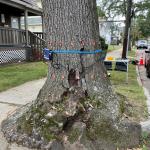
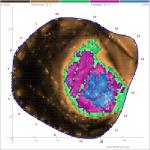 Lower trunk rot of black oak (Quercus velutina) caused by Grifola frondosa. The tree is mature (41” dbh) and resides in an urban neighborhood between a road and sidewalk, abutting a driveway. The tree leans significantly over a nearby home, in part due to competition from other trees and pruning to avoid the overhead power lines. On the driveway side, the root plate has abnormally expanded over the curbing and concrete, as some urban oaks tend to do. There’s a basal wound on the southern side of the trunk and several fruiting bodies of hen of the woods (Grifola frondosa) were located roughly 1’ from the root flare on the north side of the tree.
Lower trunk rot of black oak (Quercus velutina) caused by Grifola frondosa. The tree is mature (41” dbh) and resides in an urban neighborhood between a road and sidewalk, abutting a driveway. The tree leans significantly over a nearby home, in part due to competition from other trees and pruning to avoid the overhead power lines. On the driveway side, the root plate has abnormally expanded over the curbing and concrete, as some urban oaks tend to do. There’s a basal wound on the southern side of the trunk and several fruiting bodies of hen of the woods (Grifola frondosa) were located roughly 1’ from the root flare on the north side of the tree.
Meanwhile, no decay was found at the higher sampling plane. Overall, the tree was in good health, but given the abnormal root plate, offset decay in the lower trunk, and substantial canopy lean over the nearby home, it must be carefully monitored in the future.- Dieback of mountain witch alder (Fothergilla major) caused by suspected rodent chewing and Botryosphaeria canker. The plant is roughly 25-years-old and has been present at the site for 20 years. It resides in a mulched bed with full sun and drip irrigation. For possibly the past two years, moderate to severe dieback has developed throughout the canopy. It appears that rodent feeding (likely voles or rabbits) at the base of the plant initiated the dieback. The submitted branch and trunk sections also exhibited symptoms of cankering, with cracked, splitting bark and darkly stained vascular tissue. After incubating the symptomatic bark tissue, Botryosphaeria emerged.
- Transplant shock and Botryosphaeria shoot tip blight of Steeds Japanese holly (Ilex crenata ‘Steeds’). Approximately 40 plants were installed 13 months ago as a hedge in front of a home. The site includes full sun and drip irrigation but the soils are compacted and composed of a clay-loam. This past June, scattered shoot tips developed chlorotic foliage and the landscaper was concerned it might be a nutrient issue. Hollytone had been applied in April of 2021. Stem cankering fungi can be abundant and very damaging on Ilex crenata cultivars. The thin bark and dense canopies readily facilitate disease development. Transplant shock is a major predisposing stress that allows these existing infections to spread and cause damage. It’s critical to thoroughly scrutinize Ilex nursery stock for symptoms of stem cankering prior to purchase.
Report by Nick Brazee, Plant Pathologist, UMass Extension Plant Diagnostic Lab, UMass Amherst.
Insects
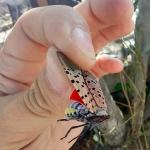 Spotted Lanternfly Population Detected for the First Time in Massachusetts!
Spotted Lanternfly Population Detected for the First Time in Massachusetts!
The MA Department of Agricultural Resources (MDAR) announced on September 28, 2021 that a small, established, and breeding population of the invasive spotted lanternfly (Lycorma delicatula) was detected in Worcester County, MA in the city of Fitchburg. This finding was confirmed by state officials.
For further details regarding what is currently known about the population in Fitchburg, MA and MDAR’s response, visit the press release: https://www.mass.gov/news/state-agricultural-officials-discover-invasive-spotted-lanternfly-population-in-worcester-county
What Should You Do?
Residents and professionals living and working across the Commonwealth should learn the life stages of the spotted lanternfly and be able to identify their eggs, immatures, and adults. At this time, it is particularly valuable to learn how to ID spotted lanternfly adults and egg masses. If any life stages of this insect are found in Massachusetts, report them immediately here: https://massnrc.org/pests/slfreport.aspx .
For More Information: https://ag.umass.edu/landscape/news/spotted-lanternfly-arrives-in-massachusetts .
Nursery Best Management Practices (January 2021)
Checklist for Residents in or near Infested Areas
Giant Garden/Leopard Slug – Handle with Care (Or Don’t)
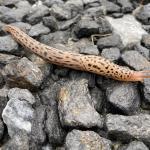
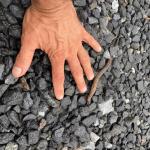 Leopard Slug/Giant Garden Slug: Limax maximus is not an insect, but rather a member of Class Gastropoda that is native to southern and western Europe, North Africa, and parts of Asia. This species was recently reported on 9/17/2021 in Berkshire County, Massachusetts, however it has been in our state and the region for quite some time. This slug was first discovered in Philadelphia, PA in 1867, but is now present in at least 38 US states, including MA, CT, ME, NH, NJ, NY, PA, VT, and others. Giant garden/leopard slugs are typically restricted to living in environments where they have access to water to avoid drying out during the day. It could be hypothesized that this species was recently noticed due to the ample rainfall during parts of the 2021 growing season in parts of Massachusetts.
Leopard Slug/Giant Garden Slug: Limax maximus is not an insect, but rather a member of Class Gastropoda that is native to southern and western Europe, North Africa, and parts of Asia. This species was recently reported on 9/17/2021 in Berkshire County, Massachusetts, however it has been in our state and the region for quite some time. This slug was first discovered in Philadelphia, PA in 1867, but is now present in at least 38 US states, including MA, CT, ME, NH, NJ, NY, PA, VT, and others. Giant garden/leopard slugs are typically restricted to living in environments where they have access to water to avoid drying out during the day. It could be hypothesized that this species was recently noticed due to the ample rainfall during parts of the 2021 growing season in parts of Massachusetts.
The giant garden/leopard slug will feed on both living or rotting plants, including tubers, fruits, leaves, roots, bulbs, and some ornamental plants and perennial herbs. While they can occasionally be pests in gardens, a relatively rare but notable risk associated with this species is its ability to carry a meningitis-causing nematode (Angiostrongylus cantonensis). This nematode can infect humans if intermediate hosts are eaten raw or undercooked. In parts of Southeast Asia, handling slugs with bare-hands has resulted in infection. To find out more about the disease caused by this nematode, visit: https://www.cdc.gov/parasites/angiostrongylus/index.html .
If you have found a giant garden slug in your garden or on a client’s property, please kill it by dropping it into a bucket of soapy water. Use gloves if handling these organisms, and wash your hands thoroughly after.
For more information about the leopard/giant garden slug, visit: http://www.tsusinvasives.org/home/database/limax-maximus .
Insects and Other Arthropods of Medical Importance:
- Mosquitoes: Seven human cases of WNV have been detected in 2021 in Bristol, Essex, and Middlesex Counties, according to the MA Department of Public Health. WNV positive mosquito samples have been identified in Barnstable, Berkshire, Bristol, Essex, Franklin, Hampden, Hampshire, Middlesex, Norfolk, Plymouth, Suffolk, and Worcester Counties. WNV risk levels have increased to High for communities Essex, Middlesex, Norfolk, and Suffolk Counties due to increasing WNV activity. Please view the risk maps available here for updates: https://www.mass.gov/info-details/massachusetts-arbovirus-update
According to the Massachusetts Bureau of Infectious Disease and Laboratory Science and the Department of Public Health, there are at least 51 different species of mosquito found in Massachusetts. Mosquitoes belong to the Order Diptera (true flies) and the Family Culicidae (mosquitoes). As such, they undergo complete metamorphosis, and possess four major life stages: egg, larva, pupa, and adult. Adult mosquitoes are the only stage that flies and many female mosquitoes only live for 2 weeks (although the life cycle and timing will depend upon the species). Only female mosquitoes bite to take a blood meal, and this is so they can make eggs. Mosquitoes need water to lay their eggs in, so they are often found in wet or damp locations and around plants. Different species prefer different habitats. It is possible to be bitten by a mosquito at any time of the day, and again timing depends upon the species. Many are particularly active from just before dusk, through the night, and until dawn. Mosquito bites are not only itchy and annoying, but they can be associated with greater health risks. Certain mosquitoes vector pathogens that cause diseases such as West Nile virus (WNV) and eastern equine encephalitis (EEE).
For more information about mosquitoes in Massachusetts, visit: https://www.mass.gov/service-details/mosquitoes-in-massachusetts .
There are ways to protect yourself against mosquitoes, including wearing long-sleeved shirts and long pants, keeping mosquitoes outside by using tight-fitting window and door screens, and using insect repellents as directed. Products containing the active ingredients DEET, permethrin, IR3535, picaridin, and oil of lemon eucalyptus provide protection against mosquitoes.
For more information about mosquito repellents, visit: https://www.mass.gov/service-details/mosquito-repellents and https://www.cdc.gov/mosquitoes/mosquito-bites/prevent-mosquito-bites.html .
- Deer Tick/Blacklegged Tick: Check out the archived TickTalk with TickReport webinars available here: https://ag.umass.edu/landscape/education-events/ticktalk-with-tickreport-webinars .
*Ixodes scapularis - We are now in the time of year when deer tick larvae and nymphs are frequently encountered. Larvae may be encountered in April, but in some locations may peak in their activity in August, while still being encountered through November. Nymphs are encountered from April through July, peaking in June. Nymphs are again present in October and November. For images of all deer tick life stages, along with an outline of the diseases they carry, and their timing of activity, visit: http://www.tickencounter.org/tick_identification/deer_tick .
Anyone working in the yard and garden should be aware that there is the potential to encounter deer ticks. The deer tick or blacklegged tick can transmit Lyme disease, human babesiosis, human anaplasmosis, and other diseases. Preventative activities, such as daily tick checks, wearing appropriate clothing, and permethrin treatments for clothing (according to label instructions) can aid in reducing the risk that a tick will become attached to your body. If a tick cannot attach and feed, it will not transmit disease. For more information about personal protective measures, visit: http://www.tickencounter.org/prevention/protect_yourself .
The Center for Agriculture, Food, and the Environment provides a list of potential tick identification and testing resources here: https://ag.umass.edu/resources/tick-testing-resources .
*Note that deer ticks (Ixodes scapularis) are not the only disease-causing tick species found in Massachusetts. The American dog tick (Dermacentor variabilis) and the lone star tick (Amblyomma americanum) are also found throughout MA. Each can carry their own complement of diseases, including others not mentioned above. Anyone working or playing in tick habitats (wood-line areas, forested areas, and landscaped areas with ground cover) should check themselves regularly for ticks while practicing preventative measures.

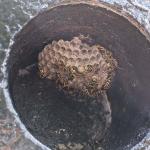 Wasps/Hornets: Many wasps are predators of other arthropods, including pest insects such as certain caterpillars that feed on trees and shrubs. Adult wasps hunt prey and bring it back to their nest where young are being reared, as food for the immature wasps. A common such example are the paper wasps (Polistes spp.) who rear their young on chewed up insects. They may be seen searching plants for caterpillars and other soft-bodied larvae to feed their young. Paper wasps can sting, and will defend their nests, which are open-celled paper nests that are not covered with a papery “envelope”. These open-celled nests may be seen hanging from eaves or other outdoor building structures, however these insects sometimes find the most interesting locations to construct their nests. These photos taken on 8/15/2021 show a paper wasp nest that was located at the end of a cannon at a town memorial park in Hampshire County, MA. So expect these nests in the oddest of locations to avoid being stung! Aerial yellow jackets and hornets create large aerial nests that are covered with a papery shell or “envelope”. Common yellow jacket species include those in the genus Vespula. Dolichovespula maculata is commonly known as the baldfaced hornet, although it is not a true hornet.
Wasps/Hornets: Many wasps are predators of other arthropods, including pest insects such as certain caterpillars that feed on trees and shrubs. Adult wasps hunt prey and bring it back to their nest where young are being reared, as food for the immature wasps. A common such example are the paper wasps (Polistes spp.) who rear their young on chewed up insects. They may be seen searching plants for caterpillars and other soft-bodied larvae to feed their young. Paper wasps can sting, and will defend their nests, which are open-celled paper nests that are not covered with a papery “envelope”. These open-celled nests may be seen hanging from eaves or other outdoor building structures, however these insects sometimes find the most interesting locations to construct their nests. These photos taken on 8/15/2021 show a paper wasp nest that was located at the end of a cannon at a town memorial park in Hampshire County, MA. So expect these nests in the oddest of locations to avoid being stung! Aerial yellow jackets and hornets create large aerial nests that are covered with a papery shell or “envelope”. Common yellow jacket species include those in the genus Vespula. Dolichovespula maculata is commonly known as the baldfaced hornet, although it is not a true hornet. 
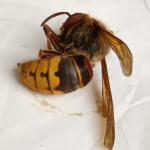 The European hornet (Vespa crabro) is three times the size of a yellow jacket and may be confused for the Asian giant hornet (Vespa mandarinia). The European hornet is known to Massachusetts, but the Asian giant hornet is not. If you are concerned that you have found or photographed an Asian giant hornet, please report it here: https://massnrc.org/pests/report.aspx . Paper wasps and aerial yellowjackets overwinter as fertilized females (queens) and a single female produces a new nest annually in the late spring. Nests are abandoned at the end of the season. Queens start new nests, lay eggs, and rear new wasps to assist in colony/nest development.Some people are allergic to stinging insects, so care should be taken around wasp/hornet nests. Unlike the European honeybee (Apis mellifera), wasps and hornets do not have barbed stingers, and therefore can sting repeatedly when defending their nests. It is best to avoid their nests, and if that cannot be done and assistance is needed to remove them, consult a professional.
The European hornet (Vespa crabro) is three times the size of a yellow jacket and may be confused for the Asian giant hornet (Vespa mandarinia). The European hornet is known to Massachusetts, but the Asian giant hornet is not. If you are concerned that you have found or photographed an Asian giant hornet, please report it here: https://massnrc.org/pests/report.aspx . Paper wasps and aerial yellowjackets overwinter as fertilized females (queens) and a single female produces a new nest annually in the late spring. Nests are abandoned at the end of the season. Queens start new nests, lay eggs, and rear new wasps to assist in colony/nest development.Some people are allergic to stinging insects, so care should be taken around wasp/hornet nests. Unlike the European honeybee (Apis mellifera), wasps and hornets do not have barbed stingers, and therefore can sting repeatedly when defending their nests. It is best to avoid their nests, and if that cannot be done and assistance is needed to remove them, consult a professional.
Woody ornamental insect and non-insect arthropod pests to consider, a selected few:
Invasive Insects & Other Organisms Update:

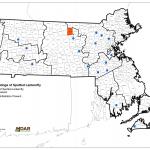
Spotted Lanternfly: (Lycorma delicatula, SLF) The MA Department of Agricultural Resources (MDAR) announced on September 28, 2021 that a small, established, and breeding population of the invasive spotted lanternfly (Lycorma delicatula) was detected in Worcester County, MA in the city of Fitchburg. This finding was confirmed by state officials.
For further details regarding what is currently known about the population in Fitchburg, MA and MDAR’s response, visit the press release: https://www.mass.gov/news/state-agricultural-officials-discover-invasive-spotted-lanternfly-population-in-worcester-county .
Residents and professionals living and working across the Commonwealth should learn the life stages of the spotted lanternfly and be able to identify their eggs, immatures, and adults. At this time, it is particularly valuable to learn how to ID spotted lanternfly adults and egg masses. If any life stages of this insect are found in Massachusetts, report them immediately here: https://massnrc.org/pests/slfreport.aspx .
Currently, the only established (breeding) population of spotted lanternfly in Massachusetts is in a small area of Fitchburg, MA. Therefore, there is no reason to be preemptively treating for this insect in other areas of Massachusetts at this time. If you suspect you have found spotted lanternfly in additional locations, please report it immediately to MDAR at the link provided above. If you are living and working in the Fitchburg area, please be vigilant and continue to report anything suspicious.
For More Information:
From UMass Extension:
https://ag.umass.edu/landscape/fact-sheets/spotted-lanternfly
From the MA Department of Agricultural Resources:
https://massnrc.org/pests/pestFAQsheets/spottedlanternfly.html
Nursery Best Management Practices (January 2021)
Checklist for Residents in or near Infested Areas
Driver’s Checklist in English or Spanish (September 2021)
Moving Industry Checklist (February 2021)
![Box tree moth adult. (Matteo Maspero and Andrea Tantardini, Centro MiRT Fondazione Minoprio [IT]) Box tree moth adult. (Matteo Maspero and Andrea Tantardini, Centro MiRT Fondazione Minoprio [IT])](/sites/ag.umass.edu/files/styles/150x150/public/pest-alerts/images/content/box_tree_moth_courtesy_of_matteo_maspero_and_andrea_tantardini_centro_mirt_fondazione_minoprio_it.jpg?itok=pIFkiiQi)
![Box tree moth caterpillars. (Matteo Maspero and Andrea Tantardini, Centro MiRT Fondazione Minoprio [IT]) Box tree moth caterpillars. (Matteo Maspero and Andrea Tantardini, Centro MiRT Fondazione Minoprio [IT])](/sites/ag.umass.edu/files/styles/150x150/public/pest-alerts/images/content/box_tree_moth_caterpillar_courtesy_of_matteo_maspero_and_andrea_tantardini_centro_mirt_fondazione_minoprio_it.jpg?itok=BDTKHKwy) Box Tree Moth: Cydalima perspectalis is native to East Asia. It has become a serious invasive pest in Europe, where it continues to spread. The caterpillars feed mostly on boxwood, and heavy infestations can defoliate host plants. Once the leaves are gone, larvae consume the bark, leading to girdling and plant death. The box tree moth is not currently known to be established in Massachusetts, however the U.S. Department of Agriculture’s Animal and Plant Health Inspection Service (APHIS) is urging professionals and citizens to report any suspicious insects.
Box Tree Moth: Cydalima perspectalis is native to East Asia. It has become a serious invasive pest in Europe, where it continues to spread. The caterpillars feed mostly on boxwood, and heavy infestations can defoliate host plants. Once the leaves are gone, larvae consume the bark, leading to girdling and plant death. The box tree moth is not currently known to be established in Massachusetts, however the U.S. Department of Agriculture’s Animal and Plant Health Inspection Service (APHIS) is urging professionals and citizens to report any suspicious insects.
To report suspected box tree moth life stages or damage to boxwood in Massachusetts, please visit: https://massnrc.org/pests/pestreports.htm .
Females lay eggs singly or in clusters of 5 to more than 20 eggs in a gelatinous mass on the underside of boxwood leaves. Most females deposit more than 42 egg masses in their lifetime. They typically hatch within 4 to 6 days. Pupae typically first appear in April or May and are present continuously through the summer and into the fall, depending on the local climate and timing of generations. Adults first emerge from the overwintering generation between April and July, depending on climate and temperature. Subsequent generations are active between June and October. Adults typically live for two weeks after emergence. The exact timing of the life cycle of this insect in Massachusetts is not currently known.
The Massachusetts Department of Agricultural Resources (MDAR) recently reported that the U.S. Department of Agriculture’s Animal and Plant Health Inspection Service (APHIS) has confirmed the presence of box tree moth in the continental United States and is taking action alongside state partners and industry to contain and eradicate the invasive pest that was imported on nursery plants shipped from Ontario, Canada. For a recent press release regarding this insect from the MA Department of Agricultural Resources, visit: https://www.mass.gov/news/state-agricultural-officials-urge-public-to-inspect-boxwood-shrubs-for-box-tree-moths .
Between August 2020 and April 2021, a nursery in St. Catharines, Ontario shipped boxwood (Buxus species) that may have been infested with box tree moth to locations in six states—25 retail facilities in Connecticut, Massachusetts, Michigan, New York, Ohio, and South Carolina—and a distribution center in Tennessee. At this time, the pest has been identified in three facilities in Michigan, one in Connecticut, and one in South Carolina, and APHIS is working with state plant regulatory officials to determine whether other facilities may be impacted. For more information, visit: https://www.aphis.usda.gov/aphis/newsroom/stakeholder-info/sa_by_date/sa-2021/sa-05/box-tree-moth .
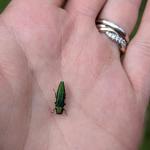 Emerald Ash Borer: (Agrilus planipennis, EAB) in 2021 alone, the Massachusetts Department of Conservation and Recreation has confirmed at least 28 new community detections of emerald ash borer in Massachusetts. To date, 11 out of the 14 counties in Massachusetts have confirmed emerald ash borer. (The remaining counties where EAB has yet to be detected are Barnstable, Dukes, and Nantucket counties.) A map of these locations and others previously known across the state may be found here: https://ag.umass.edu/fact-sheets/emerald-ash-borer.
Emerald Ash Borer: (Agrilus planipennis, EAB) in 2021 alone, the Massachusetts Department of Conservation and Recreation has confirmed at least 28 new community detections of emerald ash borer in Massachusetts. To date, 11 out of the 14 counties in Massachusetts have confirmed emerald ash borer. (The remaining counties where EAB has yet to be detected are Barnstable, Dukes, and Nantucket counties.) A map of these locations and others previously known across the state may be found here: https://ag.umass.edu/fact-sheets/emerald-ash-borer.
This wood-boring beetle readily attacks ash (Fraxinus spp.) including white, green, and black ash and has also been found developing in white fringe tree (Chionanthus virginicus) and has been reported in cultivated olive (Olea europaea). Signs of an EAB infested tree may include D-shaped exit holes in the bark (from adult emergence), “blonding” or lighter coloration of the ash bark from woodpecker feeding (chipping away of the bark as they search for larvae beneath), and serpentine galleries visible through splits in the bark, from larval feeding beneath. It is interesting to note that woodpeckers are capable of eating 30-95% of the emerald ash borer larvae found in a single tree (Murphy et al. 2018). Unfortunately, despite high predation rates, EAB populations continue to grow.
For further information about this insect, please visit: https://ag.umass.edu/fact-sheets/emerald-ash-borer . If you believe you have located EAB-infested ash trees, particularly in an area of Massachusetts not identified on the map provided, please report here: https://massnrc.org/pests/eabreport.htm .

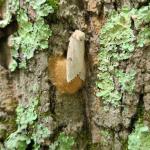
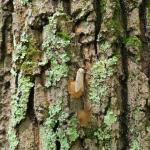 Lymantria dispar: (Formerly Gypsy Moth; LD) Professionals working in parts of Berkshire County (ex. Alford, Great Barrington, Richmond, Sheffield, South Egremont, and Williamstown) as well as NY and CT report being deluged with questions from property owners looking to manage Lymantria dispar caterpillars in 2022 following expanding populations of this insect in those areas this season. Here is some information to help with those discussions:
Lymantria dispar: (Formerly Gypsy Moth; LD) Professionals working in parts of Berkshire County (ex. Alford, Great Barrington, Richmond, Sheffield, South Egremont, and Williamstown) as well as NY and CT report being deluged with questions from property owners looking to manage Lymantria dispar caterpillars in 2022 following expanding populations of this insect in those areas this season. Here is some information to help with those discussions:
In high populations of Lymantria dispar (formerly gypsy moth), scraping egg masses can be a futile effort. When populations are high, caterpillars can blow in from surrounding forested areas onto your property (next spring) even after an egg mass scraping effort is undertaken. Additionally, on large trees, female moths can lay their egg masses in areas that are not practical/safe to reach. However, if you do try to remove egg masses from high value specimen trees this fall and winter, be sure to scrape them into a can of soapy water. If scraped onto the ground, they may still hatch next spring.
A good plan would be to have an arborist come monitor the property and surrounding area this fall/winter once Lymantria dispar females are completely done laying eggs. (Additional egg mass survey information will also be available for Massachusetts through the Department of Conservation and Recreation once surveys are complete for 2021, here: ( https://www.mass.gov/guides/lymantria-dispar-gypsy-moth-in-massachusetts ). If there are large numbers of egg masses on your property and in the woods nearby, consider applying reduced risk insecticides next spring to protect high-value specimen trees from defoliation next year, especially if they could become hazardous if they were to decline. (Ex. trees near the home, garage, etc.) Applications would be made following 90-100 GDD's, after eggs have hatched, and caterpillars have settled to feed. Egg hatch begins roughly around the first week in May in MA, however this timing may depend upon spring temperatures. Special care should also be taken to protect trees that were defoliated this year, as two consecutive years of defoliation are often very stressful even for mature trees. Young trees/new plantings should be protected as well.
After caterpillars hatch, and once they settle to begin feeding (when they are approximately 3/4 inch in length or less), they are very susceptible to applications of the reduced risk insecticide known as Bacillus thuringiensis Kurstaki. This is a soil dwelling bacterium that is lethal to the caterpillars if they ingest it on the leaves. Another reduced risk option is the active ingredient spinosad (also derived from a soil dwelling bacterium). Spinosad should not be applied to plants in bloom, as it is toxic to pollinators - but that toxicity goes away once the product dries (in about 3 hours). Chlorantraniliprole is another reduced risk active ingredient that can be applied to the leaves of susceptible hosts when caterpillars are young and just beginning to feed.
The efficacy of systemic insecticides for the management of Lymantria dispar is not entirely understood. However, products containing azadirachtin, abamectin, or acephate are labelled for use against this insect. Of those, azadirachtin is a reduced risk insecticide. With regard to acephate, some research suggests that it is more effective at managing caterpillars feeding on smaller diameter trees than on larger trees (Dan Herms, Personal Communication).
LD moth has been in Massachusetts since the 1860's. This invasive insect from Europe often goes unnoticed, thanks to population regulation provided by the entomopathogenic fungus, E. maimaiga, as well as a NPV virus specific to LD moth caterpillars. (And to a lesser extent many other organisms, including other insects, small mammals, and birds who feed on LD moth.) However, if environmental conditions do not favor the life cycle of the fungus, outbreaks of LD moth caterpillars are possible. (Such as most recently from 2015-2018, with a peak in the LD moth population in 2017 in Massachusetts.)
Check out Episode 1 of InsectXaminer to reminisce about the 2015-2018 outbreak of this insect and learn more about the fungus and the virus and how to recognize caterpillars that have been killed by these pathogens: https://ag.umass.edu/landscape/education-events/insectxaminer .
- Asian Longhorned Beetle: (Anoplophora glabripennis, ALB) Look for signs of an ALB infestation which include perfectly round exit holes (about the size of a dime), shallow oval or round scars in the bark where a female has chewed an egg site, or sawdust-like frass (excrement) on the ground nearby host trees or caught in between branches. Be advised that other, native insects may create perfectly round exit holes or sawdust-like frass, which can be confused with signs of ALB activity.
The regulated area for Asian longhorned beetle is 110 miles2 encompassing Worcester, Shrewsbury, Boylston, West Boylston, and parts of Holden and Auburn. If you believe you have seen damage caused by this insect, such as exit holes or egg sites, on susceptible host trees like maple, please call the Asian Longhorned Beetle Eradication Program office in Worcester, MA at 508-852-8090 or toll free at 1-866-702-9938.
To report an Asian longhorned beetle find online or compare it to common insect look-alikes, visit: http://massnrc.org/pests/albreport.aspx or https://www.aphis.usda.gov/pests-diseases/alb/report .

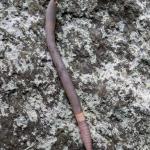 Jumping Worms: In recent years, public concern about Amynthas spp. earthworms, collectively referred to as “jumping or crazy or snake” worms, has dramatically increased. University researchers and Extension groups in many locations in the US are finding that these species cause not only forest ecosystem disturbances, but may also negatively impact soil structure and reduce plant growth in gardens and managed landscapes. They do this by voraciously devouring the organic layer of the soil while feeding very close to the soil surface, unlike other species of earthworms. In woodland areas, they can quickly eat all of the leaf litter on the forest floor. Jumping worms also leave a distinct grainy soil full of worm castings. The soil becomes granular and may look like dried coffee grounds.
Jumping Worms: In recent years, public concern about Amynthas spp. earthworms, collectively referred to as “jumping or crazy or snake” worms, has dramatically increased. University researchers and Extension groups in many locations in the US are finding that these species cause not only forest ecosystem disturbances, but may also negatively impact soil structure and reduce plant growth in gardens and managed landscapes. They do this by voraciously devouring the organic layer of the soil while feeding very close to the soil surface, unlike other species of earthworms. In woodland areas, they can quickly eat all of the leaf litter on the forest floor. Jumping worms also leave a distinct grainy soil full of worm castings. The soil becomes granular and may look like dried coffee grounds.
Unfortunately, there are currently no research-based management options available for these earthworms. So prevention is essential – preventing their introduction and spread into new areas is the best defense against them. Adult jumping worms can be 1.5 – 8 inches or more in length. Their clitellum (collar-like ring) is roughly located 1/3 down the length of the worm (from the head) and is smooth and cloudy-white and constricted. These worms may also wiggle or jump when disturbed, and can move across the ground in an S-shape like a snake. While the exact timing of their life cycle in MA might not be completely understood, their life cycle may be expected to go (roughly) something like this: they hatch in the late spring in 1-4 inches of soil, mature into adults during the summer and adults lay eggs sometime in August, and it is thought that their cocoons overwinter. (Adults perish with frost.) It is also worth noting here that jumping worms do not directly harm humans or pets.
For more information, listen to Dr. Olga Kostromytska’s presentation here: https://ag.umass.edu/landscape/education-events/invasive-insect-webinars
*NEW*: UMass Extension Fact Sheets:
Earthworms in Massachusetts – History, Concerns, and Benefits: https://ag.umass.edu/landscape/fact-sheets/earthworms-in-massachusetts-history-concerns-benefits
Jumping/Crazy/Snake Worms – Amynthas spp.:
https://ag.umass.edu/landscape/fact-sheets/jumpingcrazysnake-worms-amynthas-spp
Suggested reading includes Dr. Kostromytska’s recent “Hot Topics” article in Hort Notes (including an identification guide), here: https://ag.umass.edu/landscape/newsletters/hort-notes/hort-notes-2021-vol-323
Additional resources can also be found here:
University of Minnesota Extension: https://extension.umn.edu/identify-invasive-species/jumping-worms
Cornell Cooperative Extension: http://ulster.cce.cornell.edu/environment/invasive-pests/jumping-worm
UNH Extension: https://extension.unh.edu/blog/invasive-spotlight-jumping-worms
Tree & Shrub Insects & Mites:
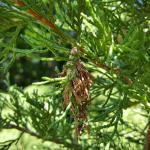 Bagworm: Thyridopteryx ephemeraeformis is a native species of moth whose larvae construct bag-like coverings over themselves with host plant leaves and twigs. In certain areas across MA in 2020, increased populations of bagworms were observed and reported, particularly in urban forest settings and managed landscapes. More information can be found here: https://ag.umass.edu/landscape/fact-sheets/bagworm
Bagworm: Thyridopteryx ephemeraeformis is a native species of moth whose larvae construct bag-like coverings over themselves with host plant leaves and twigs. In certain areas across MA in 2020, increased populations of bagworms were observed and reported, particularly in urban forest settings and managed landscapes. More information can be found here: https://ag.umass.edu/landscape/fact-sheets/bagworm
These caterpillars develop into moths as adults. Their behaviors, life history, and appearance are interesting. The larvae (caterpillars) form “bags” or cases over themselves as they feed using assorted bits of plant foliage and debris tied together with silk. As the caterpillars feed and grow in size, so does their “bag”. Young, early instar caterpillars may feed with their bag oriented skyward, skeletonizing host plant leaves. As these caterpillars grow in size, they may dangle downward from their host plant, and if feeding on a deciduous host, they can consume the leaves down to the leaf veins. Pupation can occur in southern New England in late September or into October and this occurs within the “bag”. Typically, this means that the caterpillars could encounter a killing frost and die before mating could occur. However, in warmer areas of Massachusetts or if we experience a prolonged, warm autumn, it is possible for this insect to overwinter and again become a problem the following season. If the larvae survive to pupation, adult male moths emerge and are winged, able to fly to their flightless female mates. The adult male is blackish in color with transparent wings. The female is worm-like; she lacks eyes, wings, functional legs, or mouthparts. The female never gets the chance to leave the bag she constructs as a larva. The male finds her, mates, and the female moth develops eggs inside her abdomen. These eggs (500-1000) overwinter inside the deceased female, inside her bag, and can hatch roughly around mid-June in southern New England. Like other insects with flightless females, the young larvae can disperse by ballooning (spinning a silken thread and catching the wind to blow them onto a new host). While arborvitae and junipers can be some of the most commonly known host plants for this insect, the bagworm has a broad host range including both deciduous and coniferous hosts numbering over 120 different species. Bagworm has been observed on spruce, Canaan fir, honeylocust, oak, European hornbeam, rose, and London planetree among many others.
This insect can be managed through physical removal, if they can be safely reached. Squeezing them within their bags or gathering them in a bucket full of soapy water (or to crush by some other means) can be effective ways to manage this insect on ornamental plants. Early instar bagworm caterpillars can be managed with Bacillus thuringiensis var. kurstaki (Btk) but this is most effective on young bagworms that are approximately no larger than ¾ inch in length. As bagworms grow in size, they may also have behavioral mechanisms for avoiding chemical management. At this point in the season, physical removal (if possible) may be the best option. This will also preserve any natural enemies that would be found attacking this insect, such as certain parasitic wasps. It is also important to note that the bags from dead bagworms will remain on the host plant, so check the viability of the bagworms by dissecting their bags to avoid unnecessary chemical applications. Historically in Massachusetts, bagworms have been mostly a problem coming in on infested nursery stock. With females laying 500-1000 eggs, if those eggs overwinter the population can grow quite large in a single season on an infested host. Typically this insect becomes a problem on hedgerows or plantings nearby an infested host plant. Thyridopteryx ephemeraeformis is found from Massachusetts to Florida, and is typically a more significant pest in southern climates. However, in recent years (2019-2021), bagworm appears to be overwintering in successfully in certain locations in Massachusetts.
- Fall Home-Invading Insects: Various insects, such as ladybugs, boxelder bugs, seedbugs, and stink bugs will begin to seek overwintering shelters in warm places, such as homes, throughout the next couple of months. While such invaders do not cause any measurable structural damage, they can become a nuisance especially when they are present in large numbers. While the invasion has not yet begun, if you are not willing to share your home with such insects, now should be the time to repair torn window screens, repair gaps around windows and doors, and sure up any other gaps through which they might enter the home.
- Spruce Spider Mite: Oligonychus ununguis is a cool-season mite whose hosts include spruce, arborvitae, juniper, hemlock, pine, Douglas-fir, and occasionally other conifers. This particular species becomes active in the spring and can feed, develop, and reproduce through roughly June. When hot, dry summer conditions begin, this spider mite will enter a summer-time dormant period (aestivation) until cooler temperatures return in the fall. This particular mite may prefer older needles to newer ones for food. Magnification is required to view spruce spider mite eggs. Tapping host plant branches over white paper may be a useful tool when scouting for spider mite presence. (View with a hand lens.) Spider mite damage may appear on host plant needles as yellow stippling and occasionally fine silk webbing is visible.
Spruce spider mite populations build again, following their summertime dormancy, in late August to mid-September (2375-2806 GDD’s). It is possible to scout for spruce spider mites by tapping branches over a white piece of paper or other white surface, then viewing them with a hand lens or other magnification. A general rule of thumb is that if 10 or more spruce spider mites are found per branch (in the absence of predatory mites), chemical management might be necessary (if you are also seeing roughly 10% of the foliage with stippling/discoloration). However, if you are finding light-colored and tear-drop shaped and fast-moving predatory mites, at a ratio of approximately 1 predatory mite: 10 spruce spider mites, these beneficial insect relatives may be able to help naturally keep spruce spider mite populations below damaging levels. It is important to also scout for predatory mites and beneficial insects (hover fly larvae, lacewing larvae, and lady beetle larvae and adults) while scouting for spruce spider mite, because knowledge of the presence of these beneficial predators will impact your management decisions. Broad spectrum insecticides/miticides should not be used to manage spruce spider mite on host plants where predatory mites are present as these chemicals could kill the predatory mites and lead to a subsequent surge in spruce spider mite populations.
- Viburnum Leaf Beetle: Pyrrhalta viburni is a beetle in the family Chrysomelidae that is native to Europe, but was found in Massachusetts in 2004. This beetle feeds exclusively on many different species of viburnum, which includes, but is not limited to, susceptible plants such as V. dentatum, V. nudum, V. opulus, V. propinquum, and V. rafinesquianum. Some viburnum have been observed to have varying levels of resistance to this insect, including but not limited to V. bodnantense, V. carlesii, V. davidii, V. plicatum, V. rhytidophyllum, V. setigerum, and V. sieboldii. More information about viburnum leaf beetle may be found at http://www.hort.cornell.edu/vlb/ .
Concerned that you may have found an invasive insect or suspicious damage caused by one? Need to report a pest sighting? If so, please visit the Massachusetts Introduced Pests Outreach Project: http://massnrc.org/pests/pestreports.htm .
Reported by Tawny Simisky, Extension Entomologist, UMass Extension Landscape, Nursery, & Urban Forestry Program
Weeds
Japanese knotweed, Polygonum cuspidatum, has come to the end of its flowering period with most populations having full flower drop with only seeds present on the flower stalks. Herbicide application should continue as long as the leaves are still green (greater than 75% green). Glyphosate-based herbicide products are the best choice for the control of Japanese knotweed. In areas near water, a formulation of glyphosate that is labeled for near water will need to be used. Non-chemical products containing clove oil, citric acid, acetic acid and/or orange extract will not effectively control Japanese knotweed.
Poison ivy can be treated now. Glyphosate or triclopyr are the best herbicides for poison ivy control. Triclopyr products should be selected over glyphosate products in areas where grasses need to be saved. Contact (Scythe, Reward) or the non-chemical/organic herbicide products will provide “burndown” activity only and will not adequately control poison ivy.
Many winter annual weeds will be germinating in the next month and a half so now is the time to mulch landscape beds or areas that are known to have populations of winter annual weeds. Some common landscape winter annual weeds:
mouse-ear cress Arabidopsis thaliana
thymeleaf sandwort Arenaria serpyllifolia
downy brome Bromus tectorum
shepherd's-purse Capsella bursa-pastoris
bittercress Cardamine hirsuta
sticky chickweed Cerastium viscosum
horseweed Conyza canadensis
spring whitlowgrass Draba verna
henbit Lamium amplexicaule
red deadnettle Lamium purpureum
field pepperweed Lepidium campestre
Virginia pepperweed Lepidium virginicum
pineappleweed Matricaria matricariodes
annual bluegrass Poa annua
knawel Scleranthus annuus
common chickweed Stellaria media
field pennycress Thlaspi arvense
corn speedwell Veronica arvensis
purslane speedwell Veronica peregrina
Summer annual weeds have become very large at this point in the season. Treating them with a non-selective herbicide will result in unsightly dead vegetation, so hand weeding may be necessary. Consider physical removal followed by a fresh mulch layer. This will cover any plants you could not remove as well as provide protection against the winter annual weeds mentioned above.
Now is the time to reflect on the past growing season. Focus on aspects of your weed management program – what was successful and what did not live up to your expectations. This exercise will be valuable as you begin to plan for next season. If there happens to be a pattern of “try the same thing over and over and expect a different result” an honest reflection will help break it.
Report by Randy Prostak, Weed Specialist, UMass Extension Landscape, Nursery and Urban Forestry Program
Additional Resources
Pesticide License Exams - The MA Dept. of Agricultural Resources (MDAR) is now holding exams online. For more information and how to register, go to: https://www.mass.gov/pesticide-examination-and-licensing.
To receive immediate notification when the next Landscape Message update is posted, join our e-mail list or follow us on Facebook.
For a complete listing of upcoming events, see our upcoming educational events https://ag.umass.edu/landscape/upcoming-events
For commercial growers of greenhouse crops and flowers - Check out UMass Extension's Greenhouse Update website
For professional turf managers - Check out Turf Management Updates
For home gardeners and garden retailers - Check out our home lawn and garden resources.
Diagnostic Services
UMass Laboratory Diagnoses Landscape and Turf Problems - The UMass Extension Plant Diagnostic Lab is available to serve commercial landscape contractors, turf managers, arborists, nurseries and other green industry professionals. It provides woody plant and turf disease analysis, woody plant and turf insect identification, turfgrass identification, weed identification, and offers a report of pest management strategies that are research based, economically sound and environmentally appropriate for the situation. Accurate diagnosis for a turf or landscape problem can often eliminate or reduce the need for pesticide use. For sampling procedures, detailed submission instructions and a list of fees, see Plant Diagnostic Laboratory
Soil and Plant Nutrient Testing - The University of Massachusetts Soil and Plant Nutrient Testing Laboratory is located on the campus of The University of Massachusetts at Amherst. Testing services are available to all. The lab provides test results and recommendations that lead to the wise and economical use of soils and soil amendments. For more information, visit the UMass Soil and Plant Nutrient Testing Laboratory web site. The lab is currently accepting new orders for Routine Soil Analysis (including optional Organic Matter, Soluble Salts, and Nitrate testing), Particle Size Analysis, Pre-Sidedress Nitrate (PSNT), and Soilless Media (no other types of soil analyses available at this time). Turnaround time: Please plan for the fact that date of receipt in the lab is affected by weekends, holidays, shipping time, and time for UMass Campus Mail to deliver samples to the lab.
Tick Testing - The UMass Center for Agriculture, Food, and the Environment provides a list of potential tick identification and testing options at: https://ag.umass.edu/resources/tick-testing-resources.
UMass Extension gratefully acknowledges the ongoing support of the MA Nursery and Landscape Association Fund in providing funding for a portion of the staff time required to publish the Landscape Message.